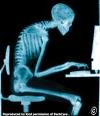In today’s modern world we spend more and more time sedentary contributing to poor posture and increased strain on our backs. According to the British Chiropractic Association there has been a significant increase in incidence of poor posture with 56% of the UK population believing they have poor posture and 72% of those questioned having suffered from back pain and nearly a third of those currently suffering.Some of the most problematic postures that I see in clinic include sitting for prolonged periods, use of computers and laptops, lack of exercise, unsupportive mattresses and carrying of heavy bags.Poor posture has a direct affect on the likelihood of us developing pain and dysfunction. Poor posture leads to abnormal stresses placed on the spine which should only be involved with minimal stress and weight bearing. Overtime these stresses can cause early degeneration of joints and discs, poor motor control and eventually pain. For example a common complaint that I see in the clinic is that of office workers with upper neck pain. With poor posture at a desk, over time we become more rounded through the shoulders which in turn creates muscle imbalances. Tightness occurs in the chest and upper neck muscles whilst weakness occurs in the lower scapular muscles and deep neck flexor muscles of the neck. This mechanism is very common and is the cause for many problems such as chronic headaches, neck pain, shoulder complaints and back pain.We can minimise the strain on our neck and backs and improve our postures by following a few simple tips. Most importantly I advise patients to change their positions frequently. Any posture is better with continued change of position. The most common postures I get asked about are: seating position in work, driving position and sleeping position.
Sitting positions: 
* Ensure your seat is adjustable (this is back and base). Whilst sitting, your hips should be slightly higher than your knees and your feet should be comfortably on the floor.
* You should have adequate lumbar support on your seat.
* The centre of your computer should be at nose level.
* Take regular breaks every 20-30 mins.
* Laptops are not designed to do long periods of work on. Laptops predispose us to poor posture as the screen is at the wrong eye level and is often used on our laps encouraging us to use them on the sofa with means the low back is unsupported and creates rounding of the shoulders.
Driving positions:
* The British Chiropractic Association recently published that 32,000 people present to a chiropractor each month with back pain caused or aggravated through poor driving position.
* The chair should be no less than the length of your shin bone.
* The back of the seat should be slightly tilted back from vertical.
* Your feet should be in a comfortable natural position on the pedals.
* Avoid wearing heels or thick soled shoes for driving in
* The steering wheel should be at a comfortable reaching distance with a slight bend in the elbows.
* Your upper back should be in contact with the chair.
* Again most importantly take regular breaks on long drives.
Sleeping positions:
* Avoid sleeping on your stomach
* Good sleeping posture keeps the spine aligned and maintains the natural curves of the spine.
* Use a pillow to maintain the natural curve of the neck.
The British Chiropractic Association has released a scheme called straighten up uk. This link takes you to a website with some recommended stretches and exercises to help improve your back health.
https://www.chiropractic-uk.co.uk/straightenup/default.aspx?m=1&mi=41
For further information about posture and back pain please do not hesitate to book in with one of our Chiropractors for a £5 Consultation.

